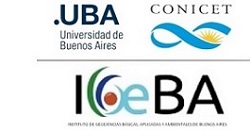Paleomagnetismo de rocas mesozoicas y cenozoicas del norte de Chile: aplicación al estudio del Oroclino Boliviano
Grado: Tesis de doctorado
Alumna: Carla Gimena Puigdomenech Negre
Año: 2019
Directores: Dr. Rubén Somoza 
Dra. Silvana Geuna 
Co-Director: Dr. Pablo Caffe
Resumen:
Los Andes Centrales constituyen el mayor sistema orogénico desarrollado enteramente
en respuesta a la subducción de corteza oceánica bajo corteza continental. Uno de los
rasgos más conspicuos de la cadena andina es el cambio en su trayectoria de NW-SE
a N-S a los 18ºS conocido en la literatura como “Oroclino Boliviano”. Si bien el patrón
de rotaciones de los Andes Centrales (CARP) concuerda a grandes rasgos con la
geometría del oroclino, los mecanismos para su génesis y la edad en la cual el
fenómeno comenzaría a manifestarse son todavía materia de discusión. El objetivo de
esta tesis es la obtención de nuevos datos paleomagnéticos a partir de rocas
mesozoicas y cenozoicas provenientes del antearco con el propósito de determinar la
existencia de uno o varios eventos de deformación involucrados en su formación. Se
analizaron 736 muestras orientadas provenientes de rocas mesozoicas y cenozoicas de
distintas zonas: Sierra de Moreno, Quebrada Chug Chug, Cuesta de Montecristo, Anticlinal
San Lorenzo, Quebrada Honda, Cerro Colorado y anticlinal Chajagua. Las muestras fueron
sometidas a diferentes procesos de desmagnetización a fin de aislar la remanencia
magnética característica y calcular las rotaciones tectónicas de los diferentes bloques.
Los resultados obtenidos en unidades del Cretácico medio indican la existencia de sitios
rotados en sentido horario y antihorario. Por el contrario, los resultados de rocas del
Cretácico Superior presentan una leve rotación horaria (~15º) o no se encuentran rotados.
Esta diferencia en magnitud y sentido sugiere que las rotaciones en rocas del Cretácico
Inferior corresponderían a rotaciones locales de bloques durante la Fase Peruana. Por
otro lado, dada la ausencia de rotaciones en rocas situadas al este de la Falla Oeste, se
propone a la misma como el límite oriental de las rotaciones en el antearco en la zona de
estudio. Dentro del marco regional, los resultados obtenidos difieren de aquellos publicados
al sur del Lineamiento Antofagasta-Calama, donde se registran grandes rotaciones horarias.
Esto sugiere una segmentación del margen posiblemente relacionado con cambios en la
reología del basamento andino, correspondiendo la transición entre los distintos patrones
de rotación de bloques al límite entre los terrenos de Chilenia al sur y Antofalla al norte.
Abstract:
The Central Andes constitute the largest orogenic system developed entirely in response
to the subduction of oceanic lithosphere beneath continental crust. One of the most
conspicuous features of the Andean chain is the change in its trajectory from NW-SE to
N-S at 18ºS known in the literature as "Bolivian Orocline". Although the Central Andes
rotations pattern (CARP) agrees roughly with the geometry of the orocline, the
mechanisms for its genesis and the age at which this phenomenon would have begun to
manifest are still a matter of discussion. The aim of this work is to obtain new
paleomagnetic data from Mesozoic and Cenozoic rocks from the forearc to determine the
existence of one or several deformation events involved in its formation. In this thesis,
736 oriented samples from Mesozoic and Cenozoic rocks from different zones were
analyzed in Sierra de Moreno, Quebrada Chug Chug, Cuesta de Montecristo, Anticlinal
San Lorenzo, Quebrada Honda, Cerro Colorado y anticlinal Chajagua. The samples were
subjected to different demagnetization processes to isolate the characteristic magnetic
remanence and calculate the tectonic rotations of the different blocks. The results obtained
from the Middle Cretaceous units indicate the existence of rotated clockwise and
counterclockwise sites. On the contrary, the data obtained from Upper Cretaceous rocks
are slightly rotated (~ 15º) or is not rotated. These differences in magnitude and sense
suggest that the rotations in rocks of the Lower Cretaceous would correspond to local
blocks rotations during the Peruvian Phase. On the other hand, given the absence of
rotations in rocks located east of the West Fault, it is proposed that this discontinuity
corresponds to the eastern limit of the rotations in the study area. Within the regional
framework, the results obtained differ from those published souths of the
Antofagasta-Calama Lineament, where large clockwise rotations are recorded. This
suggests a segmentation of the margin possibly related to changes in the rheology of
the Andean basement. This change proposes that, the transitions between areas with
different blocks rotation pattern corresponds to the boundary between Chilenia and
Antofalla terranes.
